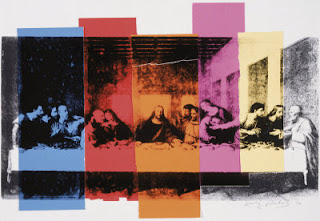In 1984, gallerist Alexandre Iolas commissioned Warhol to create a group of works based on Leonardo Da Vinci's Last Supper (1495-97) for an exhibition space in the Palazzo Stelline in Milan, located across the street from Santa Maria delle Grazie, home of Leonardo's masterpiece. Warhol exceeded the demands of the commission and produced nearly 100 variations on the theme. Indeed, the extent of the series indicates an almost obsessive investment in the subject matter, which takes on an added significance in light of the revelation of the secret religious life revealed after Warhol's death, which occurred only a month after the opening of the Milan exhibition in January 1987. The cycle also refers to the artist's use of Leonardo's Mona Lisa 20 years earlier, and to his series begun during the mid-1980s based on Renaissance and Modernist masterworks.
As he did with most subjects, Warhol approached The Last Supper through mediations of the original, working from a cheap black and white photograph of a widely circulated 19th-century engraving and a schematic outline drawing found in a 1913 Cyclopedia of Painters and Painting. The former served as model for the silkscreens, the latter for the so-called handdrawn paintings, which were made by tracing the simplified contours of the encyclopedia illustration as they were projected onto the canvas. While Warhol had practiced silkscreening since the early 1960s and throughout the '70s, he took up tracing only in 1983 during his collaborations with artists Francesco Clemente and Jean-Michel Basquiat. Some compositions appropriate Leonardo's entire pictorial design, while others explore details of individual figures and groups, singularly or in repetition, differing in orientation, scale, and color. This varied handling denies the visual unity of Leonardo's exemplary demonstration of one-point perspective as well as the painting's spiritual content by favoring a visual multiplicity and by including references to popular culture. Advertising logos for Wise Potato Chips, Dove Soap, and General Electric (a feature of Warhol's pictures that can be traced back to his Campbell's soup cans of the early 1960s) are superimposed on the figures of Christ and the Apostles, creating a hybrid of the sacred and profane, high art and commercial design. The seemingly heretical irreverence for these distinctions reflects the inevitable transformation of a deeply religious work into a cliché whose spiritual message has become muted through repetition. As Warhol's final series, The Last Supper serves as a powerful reiteration of the principles that informed his entire artistic enterprise.
--Claudia Schmuckli, Curatorial Assistant
This exhibition is made possible by support from The Brant Foundation, which provides loans of contemporary art to cultural institutions worldwide, and the Ayn Foundation.



No comments:
Post a Comment